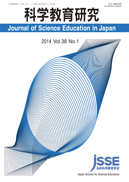Volume 43, Issue 4
Displaying 1-18 of 18 articles from this issue
- |<
- <
- 1
- >
- >|
-
2019Volume 43Issue 4 Pages 287
Published: 2019
Released on J-STAGE: April 01, 2020
Download PDF (1035K)
Special Article
Research Article
-
2019Volume 43Issue 4 Pages 291-298
Published: 2019
Released on J-STAGE: April 01, 2020
Download PDF (2101K) -
2019Volume 43Issue 4 Pages 299-307
Published: 2019
Released on J-STAGE: April 01, 2020
Download PDF (1936K) -
2019Volume 43Issue 4 Pages 308-322
Published: 2019
Released on J-STAGE: April 01, 2020
Download PDF (3601K) -
2019Volume 43Issue 4 Pages 323-332
Published: 2019
Released on J-STAGE: April 01, 2020
Download PDF (1145K) -
2019Volume 43Issue 4 Pages 333-344
Published: 2019
Released on J-STAGE: April 01, 2020
Download PDF (2690K) -
2019Volume 43Issue 4 Pages 345-352
Published: 2019
Released on J-STAGE: April 01, 2020
Download PDF (1136K) -
2019Volume 43Issue 4 Pages 353-361
Published: 2019
Released on J-STAGE: April 01, 2020
Download PDF (2559K) -
2019Volume 43Issue 4 Pages 362-372
Published: 2019
Released on J-STAGE: April 01, 2020
Download PDF (2012K) -
2019Volume 43Issue 4 Pages 373-384
Published: 2019
Released on J-STAGE: April 01, 2020
Download PDF (2270K) -
2019Volume 43Issue 4 Pages 385-397
Published: 2019
Released on J-STAGE: April 01, 2020
Download PDF (1466K)
Research Data
-
2019Volume 43Issue 4 Pages 398-410
Published: 2019
Released on J-STAGE: April 01, 2020
Download PDF (1777K) -
2019Volume 43Issue 4 Pages 411-421
Published: 2019
Released on J-STAGE: April 01, 2020
Download PDF (2131K)
General Article
Research Article
-
2019Volume 43Issue 4 Pages 423-437
Published: 2019
Released on J-STAGE: April 01, 2020
Download PDF (1694K) -
2019Volume 43Issue 4 Pages 438-450
Published: 2019
Released on J-STAGE: April 01, 2020
Download PDF (1247K) -
2019Volume 43Issue 4 Pages 451-456
Published: 2019
Released on J-STAGE: April 01, 2020
Download PDF (2456K)
Research Data
-
2019Volume 43Issue 4 Pages 457-467
Published: 2019
Released on J-STAGE: April 01, 2020
Download PDF (1614K) -
2019Volume 43Issue 4 Pages 468-474
Published: 2019
Released on J-STAGE: April 01, 2020
Download PDF (1902K)
- |<
- <
- 1
- >
- >|
